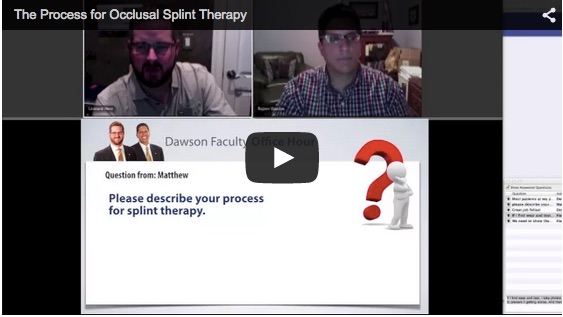- Office Hours Mon - Fri 9:00 am – 4:00 pm EST
This video is an excerpt from the April 2015 Dawson Faculty Office Hours with Drs. Leonard Hess and Rajeev Upadya. To watch the full office hours and to sign up for future office hours, visit the Videos and Webinars page.
The following is a transcription of this video excerpt.
Question: Describe your process for splint therapy
Dr. Leonard Hess: Ok that’s a great question. If we have somebody we are suspecting has an intercapsular issue, which would be a medial pole issue, then we place them in a full-coverage orthotic splint (an SRS splint) so that we are meeting the requirements of occlusal stability; we are getting even contact, canine guidance and protrusive guidance. That patient will go into splint therapy where we monitor them on a regular basis to see if the splint needs to be adjusted. As the joint becomes healthier, the splint almost becomes a bandaid. As we adjust it, we should see the joint to start to seat into the fossae again completely. We should be able to nurture the joint back into good health.

If it is somebody that the complete examination is pointing toward having a muscular type of issue and I want to calm down the muscles so that I can feel confident doing occlusal therapy, then the B-Splint is an invaluable tool. I make a lot more B-Splints than full coverage splints because I have a lot more patients that have musclar problems versus internal derangment type of issues.
So if I think it’s muscular, I put them in the B-Splint and the B-Splint is either going to calm down those muscles very quickly or it’s going to show me it’s intercapsular. You are very rarely fooled if you do your complete examination properly, though.
To recap: I’m thinking muscular or intercapsular based on what I find in the complete examination and then go down a different path based on what I find there.
ADA CERP is a service of the American Dental Association to assist dental professionals in identifying quality providers of continuing dental education. ADA CERP does not approve or endorse individual courses or instructors, nor does it imply acceptance of credit hours by boards of dentistry.
Concerns or complaints about a CE provider may be directed to the provider or to the Commission for Continuing Education Provider Recognition at ADA.org/CERP.